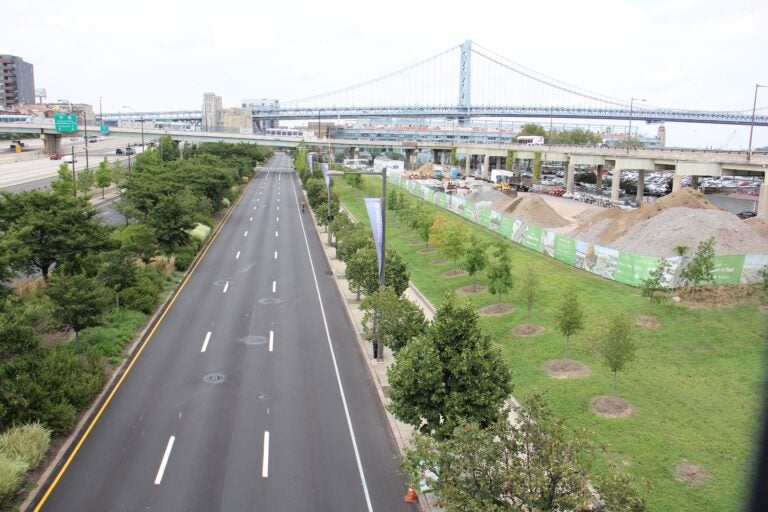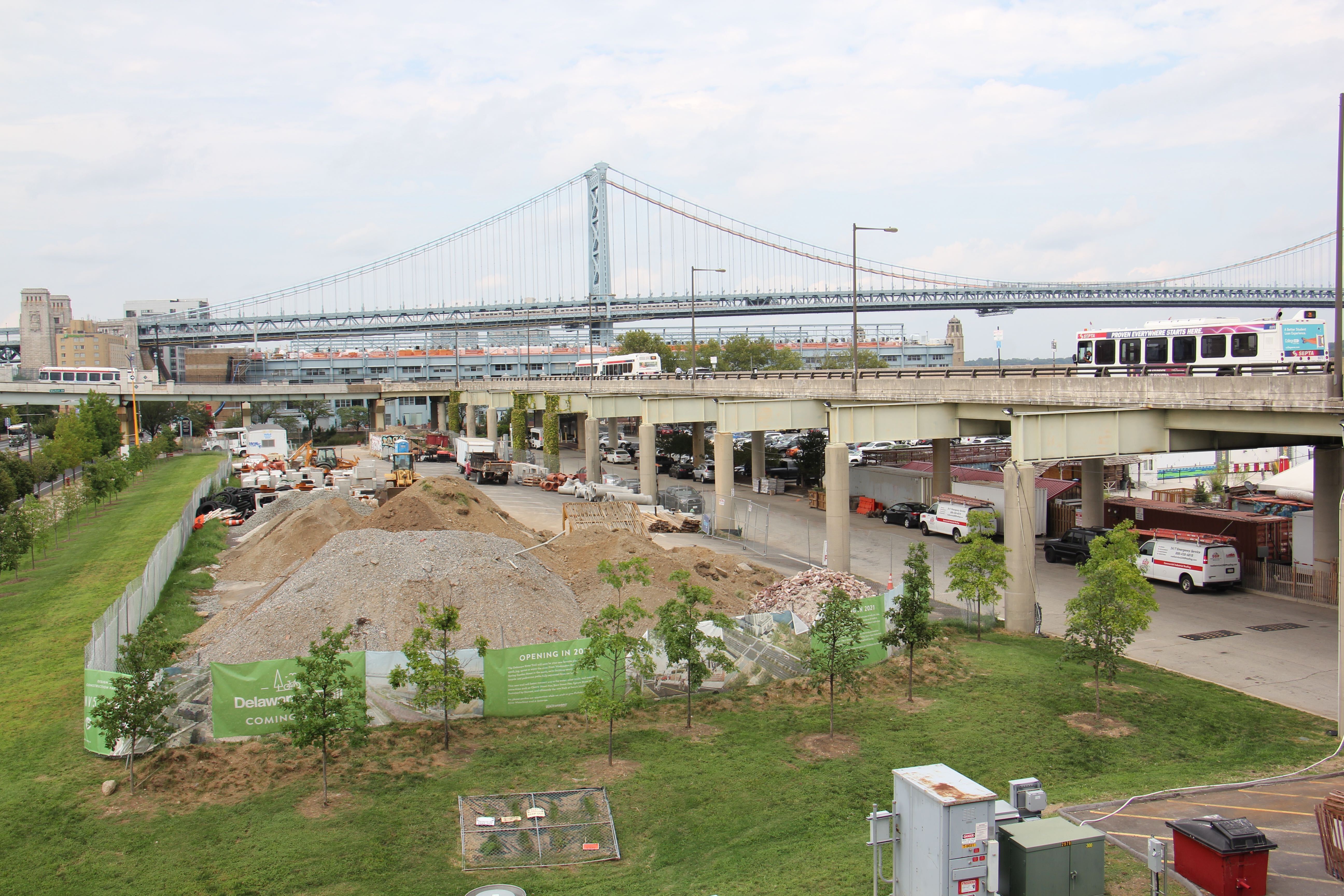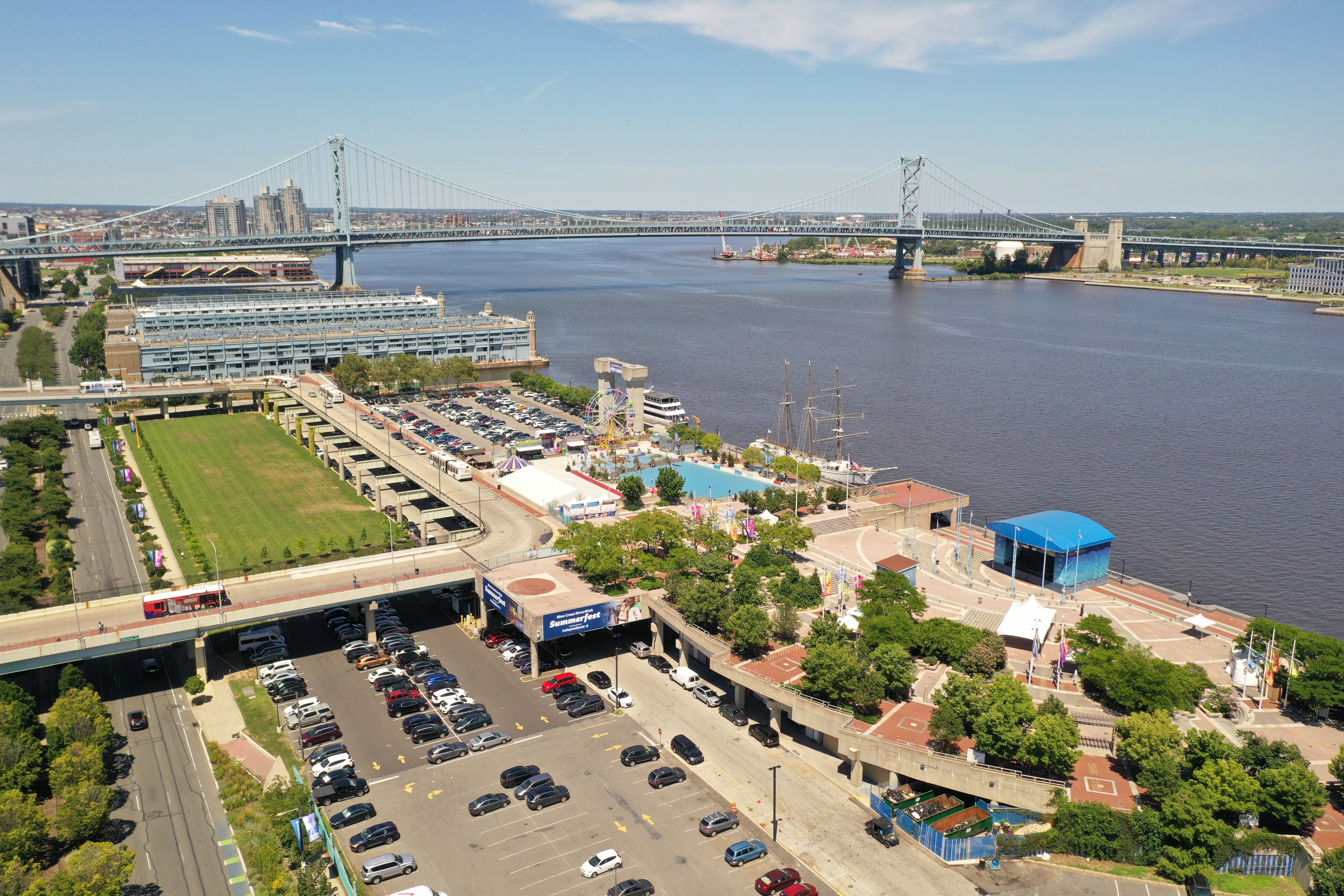Sixers’ $4B arena bid vows 35k jobs; Black and brown inclusion — goals similar projects failed to meet
A bid to relocate the 76ers to Penn’s Landing has divided Philly, with advocates seeing growth opportunities and critics wary of lost tax revenue.

Penn's Landing at Chestnut Street, looking north on Friday. The area is the site of a proposed new Sixers arena. (Emma Lee / WHYY)
Editor’s Note: This article was updated to include comment from Allentown State Sen. Pat Browne, on Monday, Aug. 31.
A proposal that would include a new home for the Philadelphia 76ers on the Delaware Riverfront at Penn’s Landing — built in part with public financing — has already ignited curiosity and controversy since plans were made public by the Philadelphia Inquirer this week.
Building trades unions hailed the project, while some prominent politicians praised the project’s promises of minority inclusion and economic impact. After a Friday meeting between elected officials and representatives for the project, State Sen. Vincent Hughes described the pitch as a “transformational” $4 billon investment that would “propel the city forward.”
“It’s dramatic. It’s huge, 35,000 jobs and 12,000 permanent jobs,” Hughes said, noting that the proposal also emphasized opportunities for Black and brown business owners.
“That is something we haven’t seen a lot of in the city. People have not gotten this opportunity.”
Some progressive politicians, like City Councilmember Helen Gym, assailed the $2 billion franchise’s quest for public support during an era of strained municipal resources.
“We cheer them on and love them. But are they tops on anyone’s list for a tax handout in normal times?”
This ire owes, in part, to heartburn, like City Hall’s $35 million bill this year for bond service linked to the construction of the Eagles and Phillies stadiums. But the pitch to relocate the NBA franchise to the waterfront by 2031 is supposed to be different –– with franchise lobbyists coaxing officials with promises of offices, residences, retail space, a school and a new African American history museum.
Most importantly, the larger project would leverage private capital and use a unique public financing mechanism known as a Neighborhood Improvement Zone that would require no upfront tax investment.
Yet this financial tool, which was used to kick-start a 30-year redevelopment of Allentown’s urban center beginning in 2009, has left its own controversial legacy in the Lehigh Valley –– and lingering questions about whether the incentive delivered economic benefits to the working-class communities of color who had invested in the area before corporate developers moved in.
A Neighborhood Improvement Zone resembles tax-increment financing, an arrangement in which money lent for development or other improvements to a certain area is paid down through the later realization of increased property tax revenues linked to those projects. The Allentown NIZ instead utilized a battery of potential tax revenue increases –– payroll, sales, alcohol, or others –– to pay down both government bonds and developers’ private loans linked to the redevelopment of a 128-acre downtown zone. That area was adjacent to a working-class neighborhood that had been growing organically largely due to an influx of Latino immigrants and businesses.
Although political dealing around the NIZ would later feature in a municipal corruption probe, the program was generally hailed as a success. Officials credit it with bringing “$1 billion in new investment” and thousands of jobs to the city, and helping finance a minor-league hockey arena.
“The NIZ incentives have turned a severely challenged downtown into one that is benefiting not only the entire Lehigh Valley but the Commonwealth of Pennsylvania as well,” said Allentown State Sen. Pat Browne, who authored the NIZ legislation, in 2018.
But Chris Woods, a Ph.D. candidate at Brown University who studied the Allentown NIZ, found that, after paying down financing costs, the zone often returned less revenue to governments than before the development took place. And, in 2018, more than half the tax revenue raised by the development went back to the developers, according to the Morning Call.
“It gives a senior claim on new tax revenues not to the [municipality], but to developers,” he said. “It’s a lot more beneficial for developers than traditional tax-increment financing.”
In an interview this week, Browne challenged Woods’ analysis. “Based on the tax receipts coming in now, the results [for local government] are dramatically better in the thousands of percent range,’ Browne said, citing a 2020 Allentown NIZ municipal fiscal impact analysis.
“The NIZ has been enormously successful in bringing significant new investment into the city’s downtown core and bringing in new revenue to support city and school district services,” the senator said. “That was the reason it was done and it is meeting that objective.”
The NIZ for the Sixers complex, which would likely require state approval, would likely differ from Allentown’s and would likely cover expenses beyond the arena itself. Initial reports indicate the franchise has promised that it would also leverage $1 billion in economic benefits for “communities of color,” and that Black-owned developer Mosaic would also be a partner on the project, which would span two parcels between Market and Chestnut streets on the waterfront.
Harris Blitzer Sports Entertainment, which owns the 76ers franchise, was unable to discuss details of the ongoing request-for-proposals process. But Ryan Boyer, president of the Philadelphia Building and Construction Trades Council, said this would set the Sixers plan apart from past stadium construction projects that were criticized for underdelivering on minority inclusion.
“We can use lessons we learned from the other stadiums,” he said. “This is different because it’s beginning with a co-developer that’s African American. From start to finish, you have minority participation.”
He further equated the project to the construction of One Liberty Place, which paved the way for more high-rise development in Center City, meaning more work for tradesmen as the arena sparks more projects nearby.
“It’s misguided to call it just a stadium plan. You have the African American Museum, you have the Seaport Museum that would be relocated. You have restaurants, you have hotels,” he said. “This is a once-in a-lifetime project.”
However, Woods’ research found that the neighborhoods adjacent to Allentown’s booming downtown saw little change in wage growth or poverty rates. Some of those neighborhoods, often low-income and predominantly Hispanic, even saw decreasing property values.
His research postulates that the diversion of city resources could be at fault.
“The local taxes sequestered by the NIZ Fund could otherwise be spent in these neighborhoods,” Woods concluded.
Akira Rodriguez, a lecturer at the University of Pennsylvania’s Weitzman School of Design and School of Social Policy and Practice, said that the full economic benefits from the proposal were “hard to predict” but questioned why the city would be in the business of financing a private stadium at all.
“As the city will certainly face a number of fiscal and social crises in the coming years, it seems shortsighted to pursue additional incentives for the city to redevelop land for such a large corporation,” she said. “It is never a good idea for municipal funds to be used for private redevelopment and profit.”
She added that the proposal seemed out of step for a league that has seen teams strike over racial inequalities in America.
“I…hope more teams will consider what it means to value Black lives and racial justice,” she said. “This includes not extracting incentives from cities with high Black populations who could use more tax revenue for public goods and services.”

The 76ers proposal differs from norms
Tax benefit deals, like the proposed NIZ, are most often used in more economically depressed areas that have struggled to attract new development. Unlike downtown Allentown in the late 2000s, the Sixers’ plan instead focuses on some of the city’s most prime real estate: adjacent to posh historic neighborhoods, where home prices and rents are among the highest in the city.
The arena would compete with other projects that applied to develop the land through an RFP process, officiated by the nonprofit Delaware River Waterfront Corp., which controls the land. Earlier public efforts struggled to revitalize the once largely industrial waterfront in the aftermath of the decline of port traffic in the 1960s, at times pinning hopes on politically complex megaprojects that failed to materialize.
But recent years saw the economic development agency pivot to a master plan that envisions the waterfront strip as “an authentic extension” of the mixed-use Old City neighborhood to the immediate west, seeking to attract a diffuse mix of private investment with profile-raising, publicly accessible amenities, like Spruce Street Harbor Park. Current plans also include reconnecting the waterfront by covering the I-95 highway trench with a $225 million cap that will double as parkland.
Real estate in the surrounding area has already become more sought after than many city neighborhoods. Neighboring parcels have attracted hundreds of new units of residential construction in recent years, with hundreds more in the works. In 2017, the Durst organization shelled out over $21 million for about four acres of piers just to the north of the proposed development.
Although Philadelphia has used similar tools to draw investment to nominally valuable downtown real estate in the past, Tim Bartik, an economist with the W.E. Upjohn Institute for Employment Research, said the Sixers proposal was an usual application.
“Unless you thought that the area around the stadium was going to sink into depression and disappear, you probably wouldn’t do this,” he said.

DRWC does not comment on ongoing RFP processes, but said it intended “to select a development partner whose vision for Penn’s Landing would support the publicly vetted Master Plan.” Others, like U.S. Rep. Brendan Boyle, raised more direct questions about the Sixers’ proposed land use, calling it “an absurd use of precious waterfront land and is in no way consistent with the larger vision of giving citizens greater access to the riverfront.”
Even beyond the nuts and bolts of the project, there are other considerations that may work in the team’s favor.
Some speculated that the entire proposal could be backed up by plans to relocate elsewhere –– New Jersey notably lavished the team with $82 million in tax incentives to move a training facility and headquarters to Camden in recent years.
“You also have to ask how likely are the Sixers to leave,” Bartik said. “Teams move all the time.”
Although DRWC says it will select a proposal within the next month, Sen. Hughes generally described Friday’s meeting as the start of a “negotiation,” saying it was too early to rush to judgment about the details of public financing.
“It’s too early, far too early, to compare one to the other,” Hughes said. “Allentown is Allentown. It’s a different city, a different community, it’s different from Philadelphia.”

Subscribe to PlanPhilly
WHYY is your source for fact-based, in-depth journalism and information. As a nonprofit organization, we rely on financial support from readers like you. Please give today.







